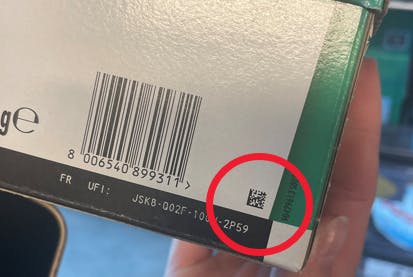
Three things we have learnt about the problem of "unknown items" at the self checkout.
The working group met in February to discuss the problem of unknown items presented at the self-checkout. Over sixty retailers joined the discussion, sharing their perspectives on the problem itself and their responses. Here are three things we learnt:
1) We really have two problems [for the price of one!] :)
The first problem occurs when the barcode is scanned / read but when the system "looks it up" there is no item or item & price in the system. This problem is also called item "Not on File"
Reasons that the item might not be on file could be that the item is new to the assortment, or it could have been discontinued, or it is not intended to be sold in this store, or is a barcode of a local supplier not associated with a master product. This list of reasons is not meant to be exhaustive.
The second problem is more simply that the barcode cannot be read. Poor packaging quality distorts the bar code quality, curved edges, and condensation are possible causes.
Other causes might be that the scanner is trying to, and failing to read another code, this could be the code used by supply chain for tracking or more commonly as we learnt on the call, trying to read a QR code. Again, this list of reasons is not meant to be exhaustive.
2) Retailers are building tools, systems and feedback loops to monitor and correct problems.
We heard in the meeting that retailers were creating regular reports and tracking systems to share with others and to quickly correct problem SKU's, a lot of the fixes were owned by Commercial, who would be responsible for addressing the problem with the vendor.
To this end, quite a few retailers had created a weekly report of problem items that was sent to the commercial teams. One retailer shared that they had created a "most manually keyed in" report for the commercial team.
Another retailer shared that they had built in code to link the alternative codes to EAN codes. Other retailers had found ways to work around the reading of QR codes but often retrospectively.
3) Unknown items create friction and the opportunity for loss
When an item cannot be scanned / read or is "Not on File" retailers would either stop the transaction, or ask shoppers to put the items to one side. Both intervention approaches add time to the shopper journey, slowing down throughput.
Most retailers were able to quantify the time for SCO hosts to resolve, which was between 12 and 24 seconds.
While few retailers in the meeting shared the scale of the problem, prior to the meeting, some data was shared with ECR on the number of unknown items found as a percentage of all items scanned for ten retailers. This small benchmark study of ten retailers suggested that unknown items represented 0.4% of all items presented at the self checkout (i.e. 4 items per 1000 scans)
If all these unknown item problems could be resolved by the SCO host, the problem would remain one of productivity and possible lost margin. However, what if the SCO host did not resolve? Would the items stay with the store or would the shopper walk away with them and cause a loss to the business? One retailer shared that they found that 10 - 14% of unknown items were not being added to the transaction.
Next Steps
It was clear from the number of registrations and interest in the meeting, that this problem is a cause of concern, adding friction to the shopping experience, draining productivity and potentially creating loss. We will "anniversary" and check in on progress made on this problem. Click below to register.
In the meantime, we will investigate undertaking some new research to identify a top 25 list of items that are not scanning.
Finally, for some extra context, click below to see the recap of the meeting and the takeaways from Professor Beck.
Feb 17, 2024
Main office
ECR Community a.s.b.l
Upcoming Meetings
Join Our Mailing List
Subscribe© 2023 ECR Retails Loss. All Rights Reserved|Privacy Policy
